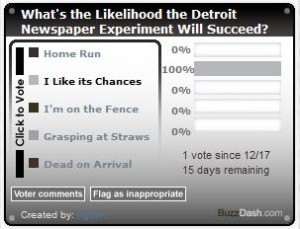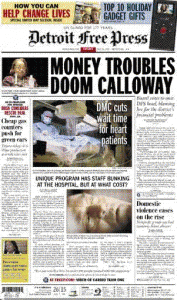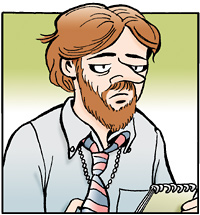We really must get back to our day job at some point, but this is too damned interesting. We spent the early morning hours scouring our favorite blogs for reaction to yesterday’s blockbuster announcement in Detroit. There was plenty:
 Mark Potts likes the Detroit model in concept, saying it could be a test bed for other innovative Gannett micro-destinations like MomsLikeMe and Metromix. But he stresses that the Detroit consortium needs to move with speed and agility to launch new services and not spend too much time fretting about how save print. “As of this week, Detroit may be the nation’s most interesting laboratory for online news,” he writes.
Mark Potts likes the Detroit model in concept, saying it could be a test bed for other innovative Gannett micro-destinations like MomsLikeMe and Metromix. But he stresses that the Detroit consortium needs to move with speed and agility to launch new services and not spend too much time fretting about how save print. “As of this week, Detroit may be the nation’s most interesting laboratory for online news,” he writes.
Steve Outing is more pessimistic. While he applauds the reduction in home-delivery frequency, he thinks charging for the Monday, Tuesday, Wednesday and Saturday editions is a bad idea and that the “digital replica” of the print editions is badder. He’s also disappointed there wasn’t more vision outlined around a mobile strategy. And he thinks the whole plan will be tweaked pretty quickly as reality sets in. He’s probably right.
Poynter Media Business Analyst Rick Edmonds has an exceptionally cogent and impartial analysis of Detroit Media’s chances of success. He notes that daily newspapers typically derive as much as half their ad revenue from Sunday editions and then spread the costs across the rest of the week. The gamble in Detroit is that reader flight precipitated by these changes won’t cancel out the cost-saving benefits.
Newspaper executives have been talking about this idea for five years, but no one has done anything with it because of the much-feared-but-never-tested theory that you don’t mess with the daily news habit. Now Detroit has no choice, and if they can pull it off, they’ll set a course for the entire industry. Edmonds likes their chances. And he adds, perceptively, “An upside is that if readers and advertisers mostly accept the change, that could pave the way to a full flip to online-only several years hence.”
Speaking of the daily news habit, Mark Potts leaves no question about where he stands. “Oh, puh-leeze,” he writes in response to an unnamed Gannett executive’s paean to the virtues of dailiness. “That thinking…is proof that newspapers are still living a fantasy that their products are the centers of their customers’ news and information universe…
It’s simply not that reducing home delivery will drive readers to other sources of news: They’re already there! They’ve been making the switch for years, relying more on the Web…”
BTW, The Detroit Free Press live-blogged the press conference. And you can watch all 42 minutes of it here.
And finally, why aren’t there any female newspaper pundits? Suggestions are welcome.
Miscellany
Canada’s largest newspaper publisher is cutting 10% of its workforce. Sun Media will eliminate 600 positions and restructure its operations in western Canada, Ontario and Quebec. The reasons are all the usual ones everyone else cites. As Mark Hamilton has pointed out, Canada has about one-tenth the population of the US, which should give you an idea of how big this cutback really is.
Veteran newspaper publisher Martin Langeveld has several predictions for 2009. On the whole, he sees newspapers’ prospects improving after a dreadful start. Among his more notable forecasts:
- No other newspaper companies will file for bankruptcy.
- Some major dailies will switch their Sunday package fully to Saturday and drop Sunday publication entirely.
- At least 25 daily newspapers will close outright
- A reporter without an active blog will start to be seen as a dinosaur.
And this one that we didn’t get at all. Please to enlighten:
- Some innovative new approaches to journalism will emanate from Cedar Rapids, Iowa.
From the AP: “The American Society of Newspaper Editors scheduled an April vote in Chicago to become simply the American Society of News Editors. Under the proposed changes, which require membership approval, editors of news Web sites also would be permitted to join, as would leaders of journalism programs.” Jeff Jarvis chuckles.
The Portland Oregonian will stop delivering to homes, stores or news boxes in the Eugene-Springfield area, which is the second largest metro region in the state. So it’s not really the Oregonian so much any more, is it?
The daily weekly Bristol Press in Connecticut will fold in mid-January if a buyer can’t be found. Owner Journal-Register Co. is shopping it and 11 other central Connecticut weeklies. The company shuttered three Philadelphia-area weeklies last week.
Did you know that the Washington Post‘s newsstand price has more than doubled in the last year? It’s true.
“What’s your favorite 21st-century newspaper innovation?” asks Slate’s Jack Shafer at the tail end of a rather dour essay on the industry’s lack of innovation. His candidates: “The incredibly clever and useful” New York Times Reader, the Times‘ Open API program, the Big Picture at the Boston Globe and Adrian Holovay’s EveryBlock.com. Send him your nominations slate.pressbox@gmail.com.
And Finally
Mark Hamilton pointed us to this cool mashup of the most e-mailed stories from newspapers around the English-speaking world. MostEmailedNews.com is one of those forehead-slappingly simple ideas that you wish you had thought of. It’s the work of a Brooklynite who calls himself Tim Brennan. It consists of only two pages at this point, but who knows where Mr. Brennan will take it. Check it out and give him some link love.

 No doubt there will be lots of analysis and reaction to follow. We see that Gannett Blog has logged 70 comments in the first four hours. We’ll keep an eye out. In the meantime, we couldn’t help taking a snapshot of the ad that appeared on the Detroit News‘s account of today’s announcement. Perhaps a cleansing is exactly what’s needed.
No doubt there will be lots of analysis and reaction to follow. We see that Gannett Blog has logged 70 comments in the first four hours. We’ll keep an eye out. In the meantime, we couldn’t help taking a snapshot of the ad that appeared on the Detroit News‘s account of today’s announcement. Perhaps a cleansing is exactly what’s needed.




![John McIntyre McIntyre [cq]](http://www.newspaperdeathwatch.com/wp-content/uploads/2008/09/mcintyre.jpg)


